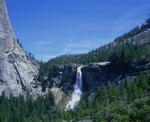The BLM El Centro Field Office, the U.S. Border Patrol, the U.S. Fish & Wildlife Service and the California Department of Fish and Game worked together over 1 1/2 days to capture a total of 21 bighorn sheep. The steep and remote terrain required that the sheep be located with a helicopter, and captured with a net fired from the aircraft at close range. Once netted, biologists restrained the animals for airlift to a base camp where they could be physically examined and fitted with a radio collar. The sheep were then airlifted back to their area of capture, and immediately released. The entire process, from capture to release, took approximately 60 minutes. A veterinarian was on hand throughout the operation, to monitor and ensure the safety of the animal. After release, all animals were active.
These 21 radio collared bighorn sheep will be tracked and monitored for potentially the rest of their lives. Biologists hope the data they obtain will help with recovery efforts of this endangered species. Scientists are interested in obtaining information about population status and trends, increasing their understanding of sheep movement between the U.S. and Mexico, determining the impact of roads as barriers, as well as the impacts of human activity on the species, and any diseases that may affect the population. The BLM El Centro Field Office supports research of this kind to help sustain the ecological balance of the natural environment.
http://www.blm.gov/ca/st/en/info/newsbytes/2012/559xtra_bighorn_airlift.html

Peninsular Bighorn Sheep are airlifted to base camp for evaluation by an inter-agency research team to better understand threats facing this endangered species. Photo: BLM/S. Tyson

15 animals were captured on BLM non-wilderness public lands managed by the El Centro Field Office. Here, the research team works quickly to examine and fit a collar to a captured animal. Photo: BLM/S. Tyson

A ewe is measured while blindfolded and hobbled. Biologists minimized stress levels to the sheep by keeping capture-to-release times to an average of 60 minutes. Photo: BLM/S. Tyson


